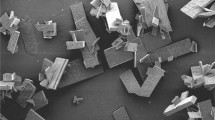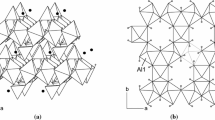Abstract
Allophanes with SiO2/Al2O3 molar ratios from 1.38 to 1.92 were heated at temperatures up to 500°C, and the changes induced were investigated by means of infrared spectroscopy (IR) and X-ray powder diffraction (XRD). Heat treatment caused the IR absorption band near 1000 cm−1 due to Si-O stretching to shift towards higher frequencies, and the band near 450 cm−1 due to O-Si-O bending to increase markedly in intensity. These results are probably due to condensation of SiO tetrahedra, following breakdown of Si-O-Al linkages and dehydroxylation of SiOH groups. Concurrent intensity increase of the IR absorption at about 700 cm−1 suggested an increase in the amount of 4-coordinated Al in the heated materials. ‘Imogolite structures’ were decomposed progressively at higher temperatures and were almost absent at about 400°C, as indicated by the weakening and disappearance of the IR band at 348 cm−1 and of the XRD reflections at 2.25 and 1.40 Å. The XRD reflection at 3.3–3.45 Å shifted to about 3.6 Å, probably as a result of thermal condensation of the silica component. The observed thermal changes were much greater for samples with low SiO2Al2O3 ratios (1.38–1.51) than for those with high ratios (1.81–1.92), indicating a lower thermal stability for the former materials. Thus, the thermal stability of allophanes appears to be related to the content of ‘imogolite structures’ and to the polymerization status of the silica component.
Резюме
Аллофаны с молярным соотношением SiO2/Аl2Оэ в диапазоне от 1,38 до 1,92 нагревались в температурах до 500°С. Перемены, вызванные этим нагревом, исследовались при помощи инфракрасной спектроскопии (IR) и порошквой рентгеновской дифракции (XRD). Нагрев образцов вызывал сдвиг полосы абсорбции IR в поблизости 1000 см−1, принадлежащей к Si–O растягивающему колебанию, к более высоким частотам, и заметное увеличение интенсивности полосы около 450 см−1, принадлежащей O–Si–O изгибающему колебанию. Эти результаты были вызваны вероятно конденсацией тетраэдров SiO после резрыва связи Si–O–Аl и дегидроксилирования групп SiOH. Одновременное увеличение интенсивности абсорбции IR в поблизости 700 см−1 указывало на увеличение количества 4-координированных А1 в нагретых образцах.” Имоголитовые структуры” раскладывались постепенно в повышенных температурах и почти отсутствовали при 400°С, на что указывало ослабление и исчезновение полос IR при 348 см−1 и отражений XRD при 2,25 и 1,40 Å. Сдвиг отражения ХРD от 3,3-3,45 Å до около 3,6 Å есть, вероятно, результатом телловой конденсации кремниевого компонента. Наблюдаемые тепловые перемены были более интенсивные для образцов с низкими соотношениями SiO2/Аl2O3 (1,38-1.51), чем для образцов с высокими соотношениями (1,81-1,92), что указывает на более инзкую тепловую устойчивость первых. Таким образом тепловая устойчивость аллофанов кажется быть связанной с количествам “имоголитовых структур” и с полимеризацией кремниевого компонента. [Е.С.]
Resümee
Allophane mit molaren SiO2/Al2O3-Verhältnissen von 1,38–1,92 wurden auf Temperaturen bis zu 500°C erhitzt. Die daraus resultierenden Veränderungen wurden mittels lnfrarotspektroskopie (IR) und Röntgenpulverdiffraktometrie (XRD) untersucht. Die Hitzebehandlung verursachte eine IR-Absorptions bande bei 1000 cm−1, die auf eine Verschiebung der Si-O-Streckschwingung nach höheren Frequenzen zurückzuführen ist. Weiters nahm die Bande bei etwa 450 cm−1, die durch eine O-Si-O-Deformationsschwingung hervorgerufen wird, beträchtlich an Intensität zu. Diese Ergebnisse werden wahrscheinlich durch eine dichtere Packung der SiO-Tetraeder verursacht, die dem Zusammenbrechen von Si-O-Al-Bindungen und einer Dehydroxylierung der SiOH-Gruppen folgt. Eine gleichzeitige Intensitätszunahme der IR-Absorption bei etwa 700 cm−1 deutete auf eine mengenmäßige Zunahme von 4-koordiniertem Al in den erhitzten Substanzen hin. “Imogolit-Strukturen” wurden bei höheren Temperaturen in zunehmendem Maße zersetzt und fehlten bei etwa 400°C nahezu vollständig. Dies ging aus der Schwächung und dem Verschwinden der IR-Bande bei 348 cm−1 und aus den XRD-Reflexen bei 2,25 und 1,40 Å hervor. Der XRD-Reflex bei 3,3–3,45 Å verschob sich nach etwa 3,6 Å, was wahrscheinlich durch eine dichtere Packung der Siliziumdioxid-Komponente auf thermischem Wege zurückzuführen ist. Die beobachteten thermischen Veränderungen waren bei Proben mit niedrigen SiO2/Al2O2-Verhältnissen (1,38–1,51) viel größer als bei Proben mit hohen Verhältnissen (1,81–1,92). Dies deutet auf eine geringere thermische Stabilität der ersten Proben hin. Aus diesem Grund scheint die thermische Stabilität der Allophane mit dem Gehalt an “Imogolit-Strukturen” und mit dem Polimerisationszustand der Siliziumdioxid-Komponente zusammenzuhängen. [U.W.]
Résumé
Des allophanes ayant des proportions molaires SiO2/Al2O3 de 1,38 à 1,92 ont été chauffés à des températures jusqu’à 500°C, et les changements induits ont été investigués au moyen de spectroscopie infrarouge (IR) et de diffraction poudrée aux rayons-X (XRD). Le traitement à la chaleur a causé la bande d’adsorption IR près de 1000 cm−1 à cause de 1’étirement Si-O de s’approcher de plus hautes fréquences, et la bande près de 450 cm−1 à cause du pliage de O-Si-O d’intensifier de manière marquée. Ces résultats sont probablement dus à la condensation de tétraèdres SiO, suivant la dissolution des liens Si-O-Al et la déshydroxylation des groupes SiOH. Un accroissement concourant d’intensité de l’adsorption IR à à peu près 700 cm−1 a suggéré un accroissement de la quantité d’Al coordonné-4 dans les matériaux échauffés. Des ’structures imogolites’ ont été progressivement décomposées à de plus hautes températures et étaient presqu’absentes à peu près 400°C, tel que l’ont montré l’affaiblissement et la disparition de la bande IR à 348 cm−1 et les réflections XRD à 2,25 et 1,40 Å. La réflection XRD à 3,3–3,45 Å s’est rapprochée de 3,6 Å, probablement un résultat de la condensation thermique du composé silice. Les changements thermiques observés étaient beaucoup plus importants pour les échantillons ayant des proportions SiO2/Al2O3 basses (1,38–1,51) que pour ceux ayant des proportions élevées ( 1,81–1,92), indiquant une stabilité thermique plus basse pour les premiers matériaux. Ainsi, il semble que la stabilité thermique des allophanes est apparentée au contenu des ’structures imogolites’ et au statut de polymérisation du composé silice. [D.J.]
Similar content being viewed by others
References
Aomine, S. and Wada, K. (1962) Differential weathering of volcanic ash and pumice resulting in formation of hydrated halloysite: Amer. Mineral. 47, 1024–1048.
Brown, G., Newman, A. C. D., Rayner, J. H., and Weir, A. H. (1978) The structure and chemistry of soil clay minerals: in The Chemistry of Soil Constituents, D. J. Greenland and M. H. B. Hayes, eds., Wiley, London, 29–178.
Egashira, K. and Aomine, S. (1974) Effects of drying and heating on the surface area of allophane and imogolite: Clay Sci. 4, 231–242.
Farmer, V. C. (1964) Infra-red spectroscopy of silicates and related compounds: in The Chemistry of Cements, H. F. W. Taylor, ed., Academic Press, London, 289–309.
Farmer, V. C., Fraser, A. R., Russell, J. D., and Yoshinaga, N. (1977) Recognition of imogolite structures in allophanic clays by infrared spectroscopy: Clay Miner. 12, 55–57.
Farmer, V. C., Fraser, A. R., and Tait, J. M. (1979) Characterization of the chemical structures of natural and synthetic aluminosilicate gels and sols by infrared spectroscopy: Geochim. Cosmochim. Acta 43, 1417–1420.
Henmi, T. (1977) The dependence of surface acidity on chemical composition (SiO2/Al2O3 molar ratio) of allophanes: Clay Miner. 12, 356–358.
Henmi, T. (1980) Effect of SiO2/Al2O3 ratio on the thermal reactions of allophane: Clays & Clay Minerals 28, 92–96.
Henmi, T. and Wada, K. (1976) Morphology and composition of allophane: Amer. Mineral. 61, 379–390.
Jackson, M. L. (1973) Soil Chemical Analysis—Advanced Course, 2nd ed., 7th Printing. Published by the author, Madison, Wisconsin, 27–95.
Klug, H. P. and Alexander, L. E. (1954) X-ray Diffraction Procedures for Poly crystalline and Amorphous Materials: Wiley, New York, 300–302, 585–633.
Mitchell, B. D., Farmer, V. C., and McHardy, W. J. (1964) Amorphous inorganic materials in soils: Adv. Agron. 16, 327–383.
Moenke, H. H. W. (1974) Silica, the three-dimensional silicates, borosilicates, and beryllium silicates: in The Infrared Spectra of Minerals, V. C. Farmer, ed., Mineralogical Society, London, 365–382.
Parfitt, R. L., Furkert, R. J., and Henmi, T. (1980) Identification and structure of two types of allophane from volcanic ash soil and tephra: Clays & Clay Minerals 28, 328–334.
Parfitt, R. L. and Henmi, T. (1980) Structure of some allophanes from New Zealand: Clays & Clay Minerals 28, 285–294.
Udagawa, S., Nakada, T., and Nakahira, M. (1969) Molecular structure of allophane as revealed by its thermal transformation: Proc. Int. Clay Conf., Tokyo, 1969, Vol. I, L. Heller, ed., Israel Univ. Press, Jerusalem, 151–159.
van Olphen, H. (1971) Amorphous clay materials: Science 171, 90–91.
Wada, K. and Harward, M. E. (1974) Amorphous clay constituents of soils: Adv. Agron. 26, 211–260.
Wada, K. and Matsubara, I. (1968) Differential formation of allophane, “imogolite” and gibbsite in the Kitakami pumice bed: Trans. 9th Int. Congr. Soil Sci., Adelaide, South Australia 3, 123–131.
Yoshinaga, N. (1966) Chemical composition and some thermal data of eighteen allophanes from Ando soils and weathered pumices: Soil Sci. Plant Nutr. 12, 47–54.
Yoshinaga, N. and Aomine, S. (1962) Allophane in some Ando soils: Soil Sci. Plant Nutr. 8, 22–29.
Yoshinaga, N. and Yamaguchi, M. (1970) Occurrence of imogolite as gel film in the pumice and scoria beds of western and central Honshu and Hokkaido: Soil Sci. Plant Nutr. 16, 215–223.
Author information
Authors and Affiliations
Rights and permissions
About this article
Cite this article
Henmi, T., Tange, K., Minagawa, T. et al. Effect of SiO2/Al2O3 Ratio on the Thermal Reactions of Allophane. II. Infrared and X-Ray Powder Diffraction Data. Clays Clay Miner. 29, 124–128 (1981). https://doi.org/10.1346/CCMN.1981.0290206
Received:
Accepted:
Published:
Issue Date:
DOI: https://doi.org/10.1346/CCMN.1981.0290206




